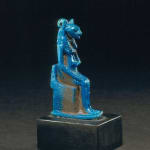Egyptian Faience Amulet of Sekhmet Enthroned, 600 BCE - 400 BCE
Faience
2
X.0132
Faience, which dates back to pre-dynastic times, of at least 5,000 years, is a glasslike non-clay substance made of materials common to Egypt: ground quartz, crushed quartz pebbles, flint, a...
Faience, which dates back to pre-dynastic times, of at least 5,000 years, is a glasslike non-clay substance made of materials common to Egypt: ground quartz, crushed quartz pebbles, flint, a soluble salt-like baking soda, lime and ground copper, which provided the characteristic color. The dried objects went into kilns looking pale and colorless but emerged a sparkling "Egyptian blue." Called tjehnet by the ancient Egyptians, meaning that which is brilliant or scintillating, faience was thought to be filled with the undying light of the sun, moon and stars and was symbolic of rebirth. Ancient Egyptians believed the small blue-green objects helped prepare them for eternity in the afterlife.
Sekhmet, along with her husband the creator-god Ptah and their son Nerfertum, was part of the powerful trio of deities that protected Ancient Memphis. She was a sun goddess, embodying the scorching, burning, destructive heat of the sun. Fierce goddess of war, the destroyer of the enemies of Ra and Osiris, she was represented as having the head of a lioness and the body of a female human. Like the sun, her temper was uncontrollable. In the legend of Ra and Hathor, Sekhmet's anger became so great, she would have destroyed all of mankind if Ra had not taken pity on us and made her drunk.
This diminutive pendant of the goddess Sekhmet is a masterpiece of intricacy. She is represented with the head of a lioness and the body of a woman seated upon a throne, holding a wadj (papyrus) scepter in her left hand. A suspension loop behind her head reveals that this work would have been worn on a necklace as an amulet. This pendant must have been particularly affective considering that it combines the imagery of the revered feline with the sacred material of faience. Certain objects, masterpieces treasured in their own time, are of an eternal beauty that is easily appreciated regardless of era or culture. This amulet is one such stunning example; a reminder of how close the glories of Ancient Egypt, from the most monumental pyramids to intimate, personal relics of faith such as this pendant.
Sekhmet, along with her husband the creator-god Ptah and their son Nerfertum, was part of the powerful trio of deities that protected Ancient Memphis. She was a sun goddess, embodying the scorching, burning, destructive heat of the sun. Fierce goddess of war, the destroyer of the enemies of Ra and Osiris, she was represented as having the head of a lioness and the body of a female human. Like the sun, her temper was uncontrollable. In the legend of Ra and Hathor, Sekhmet's anger became so great, she would have destroyed all of mankind if Ra had not taken pity on us and made her drunk.
This diminutive pendant of the goddess Sekhmet is a masterpiece of intricacy. She is represented with the head of a lioness and the body of a woman seated upon a throne, holding a wadj (papyrus) scepter in her left hand. A suspension loop behind her head reveals that this work would have been worn on a necklace as an amulet. This pendant must have been particularly affective considering that it combines the imagery of the revered feline with the sacred material of faience. Certain objects, masterpieces treasured in their own time, are of an eternal beauty that is easily appreciated regardless of era or culture. This amulet is one such stunning example; a reminder of how close the glories of Ancient Egypt, from the most monumental pyramids to intimate, personal relics of faith such as this pendant.



